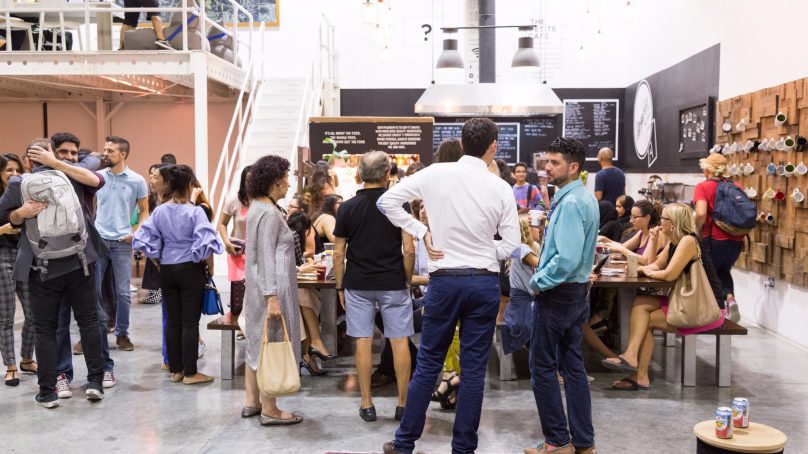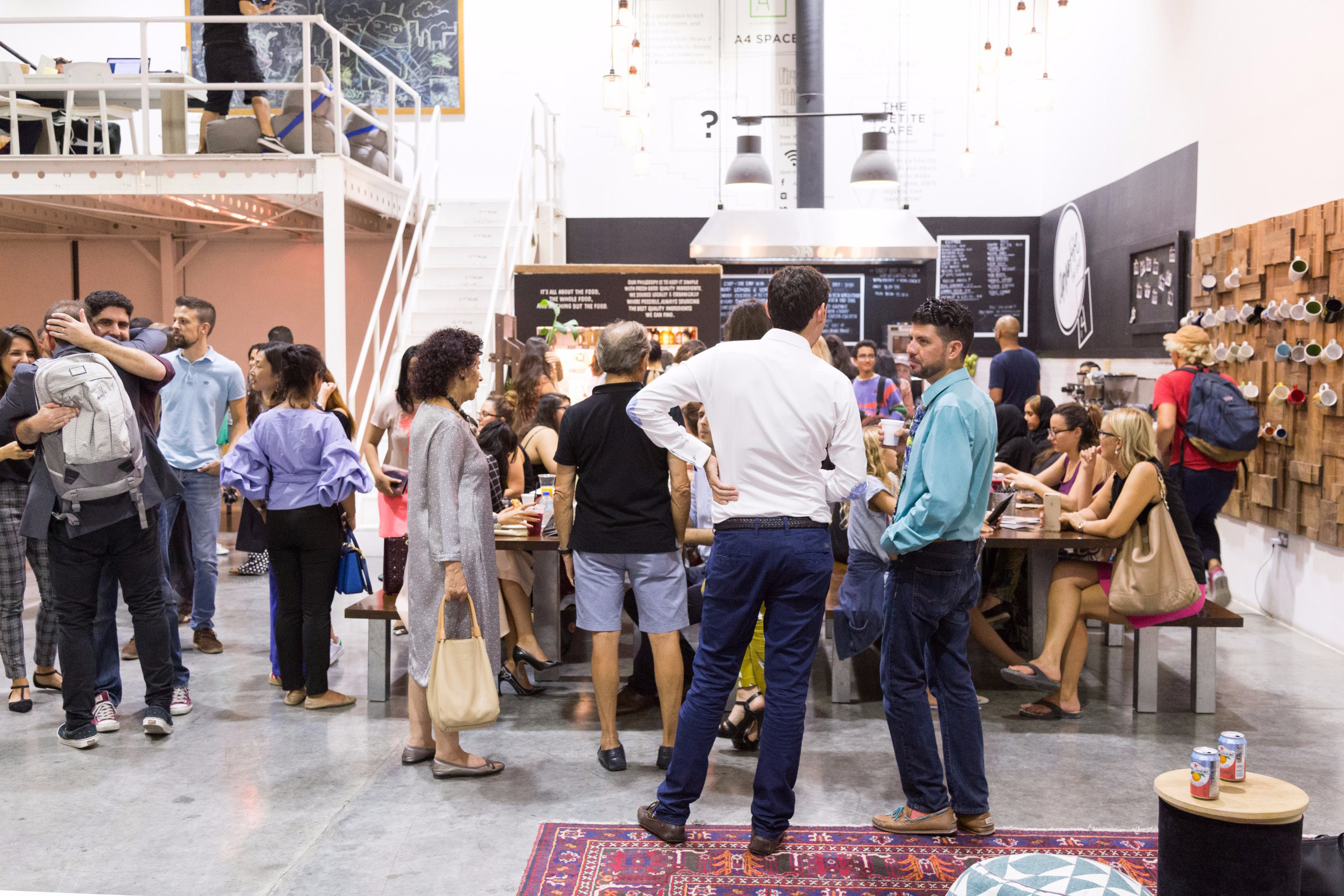An IT programmer, a social media specialist and a graphic designer walk into a coffee shop… and now it’s a co-working space. If you don’t see the humor in this joke, you probably haven’t experienced a co-working space to the full. The concept has been around for a while now, but is still fairly new in the Middle East. Nada Alameddine, partner at Hodema consulting services, fills us in on the details
What exactly is a co-working space? It is basically working alongside other people in a shared area. Unlike regular offices, individuals don’t have to belong to the same company or organization, or even do the same type of work. But the concept goes far beyond that; it’s not only about having random people seated alongside each other, but also creating a sense of community and stimulating creativity. Working independently, but together. This global shift was made possible by portable technology and connectivity, allowing people to work anywhere with a laptop and a smartphone. And it could be where the future of tech industries lies.
Working independently, but together
Directly inspired by the coffee shop working culture, the first experience resembling coworking dates back to 1989, when Regus (the pioneer of flexible office space, currently known as IWG) launched its first structure in Brussels. Then, in 1995, a group of computer engineers created a ‘hackerspace’ in Berlin called C-Base, considered a pre-model of what exists today. The goal was to exchange ideas and codes with like-minded people. Fast forward four years and the term ‘co-working’ started to spread across big cities in Europe and the US, thanks to American designer Bernie De Koven. New York firm Nutopia then opened its first ‘work club’ for the creative industry. In 2002, two Austrian entrepreneurs set up the first true co-working hub. Located in an old factory in Vienna, Schraubenfabrik houses freelancers, startups, consultants and even architects. Back in the US, in 2005, the inventor of the Twitter hashtag Chris Messina started the Hat Factory in San Francisco. Then, in 2010, WeWork opened its first location and went on to create the largest footprint in the industry. However, the sector really started to boom in 2012, by which time an estimated 2,000 co-working spaces were operating globally. That figure surpassed 18,000 in 2019 (Market Insight Reports), accommodating nearly 3 million coworkers (GCUC). The trend is expected to continue growing; by 2022, the number of co-working spaces worldwide is forecast to reach about 26,000, a 42 percent increase from 2019, as explained in the Global Coworking Growth Study 2019, published by CoworkingResources, with New York and London leading the pack. With over 80 million square feet of flexible workspace, the US drives the market in terms of real estate. The number of co-workers is forecasted to double by 2022, mostly made up of freelancers. The largest growth is expected in the Asia-Pacific region, led by China, according to the Global Co-working Unconference Conference (GCUC). Impact Hub, WeWork, Spaces, Knotel – you may have heard some of the industry’s big names. Regus is more of a platform, while Talen Garden focuses on communities rather than spaces, but they all top the market although most structures remain independently operated. And there’s something for everyone: women-only spaces, yoga studios, meditation pods, babysitter bookings, in-house nutritionists and even recording studios. These extra services make co-working spaces increasingly popular among women. The mantra is work well and do well.
The perks of co-working
So what do co-working spaces have that regular offices don’t? Why are more and more people taking the plunge? First and foremost, they’re affordable, certainly cheaper than traditional offices, which require long-term contract commitments. Users just rent what they need, from a desk to a whole floor. Most co-working hubs also provide a full range of business services, such as front desk, executive assistants, printing, access to meeting rooms and mail services. Secondly, they’re flexible. You need to change your plans at short notice? Co-working spaces can quickly adapt to your needs. A typical structure includes a mix of open space and closed offices. This is particularly useful for SMEs, startups and entrepreneurs with limited resources. Thirdly, they favor networking. Seating next to other people all day can lead to fruitful interactions and exchanges of ideas and skills, and can even start collaborations. Tech experts, writers, designers, artists, consultants and entrepreneurs are all mingling over a cup of coffee. Millennials, who now make up the largest crowd of co-workers (most of them are under 40), have gotten used to maintaining their network with a constant eye on career opportunities. And finally, co working spaces provide support. Some hubs offer training and community events; some of them tailor their events to SMEs, with incubation programs and business clinics. Surveys show that co-working reduces loneliness and boosts motivation.
In recent years, the flexible office trend has finally caught the eye of big companies, and they’re seeing how they, too, can benefit from the co-working revolution. If freelancers remain the main user group, they are now closely followed by company workers. WeWork statistics show a 90 percent increase in the number of companies and a 360 percent increase in members from companies making use of WeWork’s services in 2017. These firms included global players like Microsoft, Spotify, Pinterest and HSBC. Facebook has launched its first-ever accelerator – LDN_LAB – and Google Campus offers workspaces to its 22,000 members. The co-working business has become a key growth driver within the office market, as more and more corporate employees jump on the co-working bandwagon. The only downside is for independent solo developers setting up their co-working space. Making your structure profitable can prove to be a challenge, with rent being the main financial burden.
Late bloomers
The co-working trend is finally picking up in the region, after years of lagging behind the rest of the world. Even Dubai, which is usually one of the global trendsetters, has had a lethargic approach to the concept. This slow penetration rate has multiple explanations. In the Gulf countries, restrictive regulations and a complex licencing system had deterred foreign investors until recently. However, the authorities are now relaxing the process, resulting in an influx of new operators. Dubai Blink, the B2B smart commerce platform developed by the Dubai Airport Freezone Authority, which allows global companies to connect and trade via Dubai without having a presence on the ground, is set to boost the demand for coworking spaces, according to Colliers. Local players are also finally understanding the potential profits. Dubai currently has over 50 co-working locations, which represents a 130 percent rise since 2015. In total, the city has more than 650,000 sq ft of flexible and coworking space, the largest one being the Dubai Technology Entrepreneur Campus (DTEC). As Dubai’s rents continue to fall, large spaces that landlords are struggling to lease make great co-working opportunities.
Newcomers offer hybrid hubs – with a mix of open spaces and private offices – to cater to SMEs, freelancers and larger corporations simultaneously. The idea of communal space, as well as the importance of networking is still new and has to find its way into people’s working habits. Some concepts are standing out though: Letswork is an app connecting users, with more than 20 workspace across the UAE via a single membership. Its 2,500 members get to work from hotels, cafes, co-working spaces and venues with access to unlimited hot drinks, WiFi, free parking and meeting rooms during specific timings. One Space Dubai is also unique, as it offers all the usual services free of charge for those looking for a job. The same slow reality check is happening in Saudi Arabia, where flexible offices are only just starting to sprout up. This presents a good business opportunity, supported by the country’s Vision 2030 to diversify the economy, according to PwC’s report ‘Co-working space in Saudi Arabia: The promise and the potential’. The entrepreneurship scene is still nascent in Egypt and Jordan as well. The first hub opened in Amman in 2012 and in Cairo in 2007, with the nonprofit initiative Rasheed 22. District Spaces, 302Labs, Almaqarr, IceCairo, and Startup Haus Cairo then followed suit. The authorities are now supporting the idea, with the EgyptInnovate website and the number of spaces across the country has topped 100.
Unlike its neighbors, Lebanon has been familiar with the entrepreneur’s habits for some time. Most freelancers are regulars in coffee shops across Beirut, and several co-working concepts have opened their doors, boosted by the implementation of ‘Circular 331’ in 2014, which supports the growth of a ‘knowledge economy’ to drive innovation. While AltCity focuses on start-ups, Antwork, which has three locations in the country and one in Limassol, Cyprus, offers a work cloud, allowing users to benefit from a list of productivity tools, access to facilities using the IoT app, community programs and a private sharing cloud. Beirut Digital District (BDD), launched in 2012, hosts around 50 companies active in the ICT, digital and creative sectors. It is also home to startup accelerator programs, such as Berytech, the UK Lebanon Tech Hub and Speed@BDD. Cerviced provides more high-end services, such as a trilingual receptionist and an in house IT team. Creative freelancers can also go to The Submarine, an art and design oriented work and event space. In countries like Lebanon, where workers experience power and internet cuts on a daily basis, co-working spaces allow access to more reliable infrastructures. And if you haven’t found what you’re looking for yet, just log onto the coworker website, where you’ll be one click away from thousands of flexible offices across the globe.
hodema.net



















